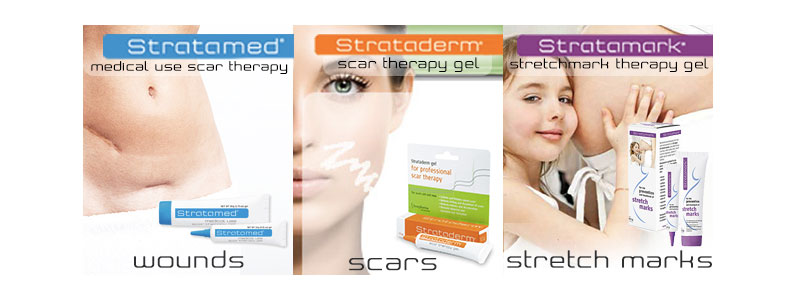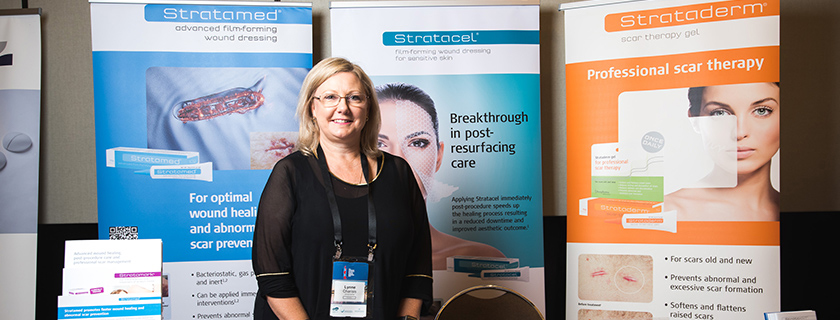
Trish: Hey, podcasters. I’m here in Melbourne at the The Advanced Aesthetic Plastic Surgery workshop and I’m having a chat with Lynne Charisis from Stratpharma. Now, Stratpharma do an incredible range of scar treatments. So we’re gonna have a bit of a talk about how to do the best thing that you can for yourself to make sure that you have as less scarring, and even none, after you’ve had procedures.
So welcome, Lynne, thanks so much for today.
Lynne Charisis: That’s a pleasure, Trish.
Trish: Awesome. So I know it’s really important when you’ve had surgery to minimise scarring. You have to actually start treating the scar at the very beginning. Can you tell us … I know we’ve got Stratamed and we’ve got Strataderm. Can you tell us what you’d use when and why you’d use what and how it can help? ‘Cause I know that a lot of doctors actually put the tape on straight away as well. But can you give us a bit of insight into how the Stratamed and the Strataderm are formulated and why?
Lynne Charisis: Sure, absolutely. So it’s important after surgery to start your scar management right from the time of the surgery. That way you minimise scarring any impact in terms of abnormal scarring, as well as get the best scar outcome even if it’s not gonna be an abnormal scar. Tapes are often used by surgeons to put pressure over the incision. What they can do, though, is as soon as you introduce something with an adhesive on the back of it, then you run the risk of having an allergic reaction to that adhesive. Lots of patients have allergic reactions to them.
Trish: I’m actually allergic to the tapes. I can’t use the tape at all.
Lynne Charisis: So you get red and raised and itchy underneath them. And that can impact the scar outcome that you have. So you want to use something that is going to have the minimal impact in terms of adverse reaction, so, allergies and those sorts of things. And silicon is actually an ingredient that does that. It’s very uncommon for anyone to have a reaction to silicon. But what silicon does, is it helps soften and flatten and keep the skin hydrated and moist so that it’s in the right environment to heal faster. And while it heals faster, you get a better scar outcome. And that’s why you want to start it right from the start, so you don’t have a gap where the skin’s not healing as fast as possible, and can impact the scar outcome that you have.
Trish: Okay. So the first product that you would use, if you were doing it straight after surgery, you would use the Stratamed
Lynne Charisis: Correct.
Trish: Is that right?
Lynne Charisis: So that’s the blue one. So Stratamed is the only silicon that is approved to use on a wound immediately after surgery.
Trish: So that means, not open, but, on top of the stitches, and when it’s not totally sealed, you can actually use the Stratamed.
Lynne Charisis: Correct. And what Stratamed will do is it’ll form a film. So it’s a silicon gel that dries to form a film. That film is actually a wound dressing. Once it’s formed into a film, it’s waterproof. It’s sealed off the incision site. It’s bacteria static. And what that means is it helps prevent infections because bacteria can’t get in. It produces the moist wound environment that gives the best healing and the fastest healing. And, by doing that, also helps to minimise scarring that you’re gonna get. So you get the best scar outcome that you can.
Trish: Okay. So basically the instructions for use is … So you’ve got your scar. You’ve just come out of surgery. You can start using it from day dot?
Lynne Charisis: From day dot. Yeah, absolutely. So, you can have a chat to your surgeon and see if they’re happy to put it on in theatre. If they’re not, then you can put it on straight away afterwards. It reduces the need- You don’t actually need to use the tape, because it actually seals the incision site, so that you don’t actually need to put a tape over the top. It’s an actual wound dressing. So, as the label says, it’s an advanced film-forming wound dressing. And once it’s in place, you’ve got a waterproof seal over the top of your incision.
Trish: Okay. So, basically, you come out of surgery, you can put it on. So, I know when I did my surgery, there’s instructions for putting it on. Correct me if I’m wrong. So you just, basically, a thin film all over the scar. And then you’ve gotta wait a few minutes for that to dry, don’t you?
Lynne Charisis: Correct. So you spread it as thinly as possible, and that way it will dry. And then, once it’s dry, you can just put your clothing over the top. If your surgeon wants you to put some sort of dressing over the top of the Stratamed, you can do that as well. So long as the Stratamed’s in contact with your skin, it’s gonna work. So you can put a secondary dressing over the top. And if you do do that, if the surgeon wants you to do that, then you don’t actually have to wait for the Stratamed to dry. You can just put your dressing over the top. And then put whatever garment that your surgeon has asked you to put on after the surgery over the top of that. If you aren’t putting the secondary dressing on, make sure your film is really thin when you put it on, and that way it will dry. And then you can just put your clothing straight over the top.
Trish: Okay, great. How many times a day do you have to apply it?
Lynne Charisis: So you would apply it to a fresh wound or a fresh incision twice a day. And that’s making sure that you’ve got the silicon in contact with the incision line 24/7, to give you the best outcome. Once your wound is healed, then you would move on to Strataderm. That’s usually around seven to 14 days, depending on your healing rate. And you can then move on to Strataderm, which is only once a day. So that makes it much easier to manage your scar long-term.
Trish: So basically, I use the Stratamed for the first- I’d probably be more comfortable with saying the first two weeks, myself, just to be sure, until everything’s all sealed up. So use the Strata- I know that I was using it in the morning after a shower. So, you have your shower. Let your body … dry yourself; pat yourself dry. Then I put the Stratamed all around my incision. Wait about four minutes or so for it to dry. And then, just being on the- I wasn’t actually putting it on at night time. But you don’t have to have a shower to put it on. You can just put it over … Okay, so you could do … Have your shower, put the Stratamed on …
Lynne Charisis: Put the Stratamed on.
Trish: And then, before you go to bed, say half an hour …
Lynne Charisis: Put it on again.
Trish: Put it on again?
Lynne Charisis: So, just a bit and that’s insurance just in case that your clothing has caused friction against your incision over the day and you might have rubbed a little bit off. So if you want the best outcome, you put it on twice a day.
Trish: All right. So, after two weeks, transfer to the Strataderm, and you only have to put it on once a day. So have your shower, put the Strataderm on, let it dry. So it’s exactly the same process, just you do it once a day.
Lynne Charisis: Correct. So Stratamed’s made to be … Because Stratamed, the blue one, goes on straight away, it’s made to bond a little less tightly to the skin. So that’s why you put it on twice a day. But Strataderm is made to be much more durable so that you only need to put it on once a day.
Trish: Okay, great. All right, everyone. So, I can’t think of any other questions. I love it. I’m a real advocate for the Stratpharma products. I absolutely love them. So that’s on scars. So while we’re actually, we’ve covered- Oh, yeah, sorry, how long do we have to use it for?
Lynne Charisis: Good question. So, in terms of scar management, you want to use a product for at least three months. That’s gonna give you the best outcome. So, Stratamed, as you said, for the first two weeks. Move on to Strataderm and continue that for three months. And you’ll get the best scar outcome that you can.
Trish: All right. I know when I first opened my first Stratamed tube, I thought, “Oh my God, this is so tiny! It’s so expensive.” But it really goes a long way.
Lynne Charisis: It does. It spreads a long way.
Trish: You don’t go using it like a normal cream. You’re quite sparse with it.
Lynne Charisis: Correct. And inside the pack is a leaflet which actually tells you how long the tube will actually last based on the size of your incision.
Trish: Okay. Oh, okay, I didn’t even read that. So if your incision is like, three inches long it’ll tell you how long the tube will last if you’re using it, probably.
Lynne Charisis: Yeah, it will. It will, absolutely. So, for your Stratamed, if you’ve got a five to eight centimetre incision, then a ten gramme tube will actually last you your full three months.
Trish: Yeah, wow. Yeah, I know you don’t need a lot. And is there a shelf life?
Lynne Charisis: Shelf life? So, yeah, the shelf life’s mandatory on medical devices. So, there’s a shelf life on all of the Stratpharma products is five years. So, if you don’t end up using all the Stratamed tube on your incision, then you put it in your medicine cabinet for when you’ve got minor burns, cuts, and grazes.
Trish: Yeah, I’ve had mine forever. ‘Cause I obviously bought a big tube and I didn’t need anywhere near as much. But we use it all the time at home, even on the kids if something happens, you know, like, “Oh, here. Come here.”
Lynne Charisis: It’s great, especially if you’re a cook that burns yourself on the oven and those sorts of things.
Trish: Oh, okay. Good for burns as well.
Lynne Charisis: Yep, perfect. And then, nappy rash as well.
Trish: Oh, wow. ‘Cause it’s a silicon.
Lynne Charisis: ‘Cause it’s silicon. Yeah.
Trish: Okay. Awesome. Well, thank you so much for your time today.
Lynne Charisis: Thank you. It’s a pleasure.
Trish: No worries. And if you guys want to find out a bit more about the product, you can actually just try typing Strataderm or Stratamed or Stratpharma on the plastic surgery hub search bar on the main page. Or, otherwise, drop us an email to [email protected]. Thanks, Lynne.
Lynne Charisis: Thanks, Trish.
Scars usually result from trauma of some kind (surgery, accident, disease) and are a natural part of the healing process. A normal scar usually develops during the first 48 hours after wound closure and fades within 3 to 12 months. However various factors can interfere with and alter the wound-healing process, causing an “overhealing” or continuation of the scarring process. As a result, an abnormal scar develops. The abnormal scar may grow bigger, fail to fade, restrict the movement of a joint, cause discomfort, itching or pain.
Abnormal scars may cause distress because of their appearance. But any scar can be perceived as a personal problem. Some may learn to accept their scar, but many never forget it. It is widely accepted by psychologists that proactively treating to reduce the visibility of a scar can actually help boost self-esteem.
Stratamed – Open Wound Scar Gel
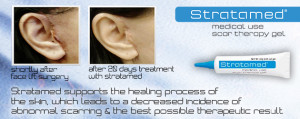
Scars – Strataderm Scar Therapy Gel – the next-generation scar therapy gel
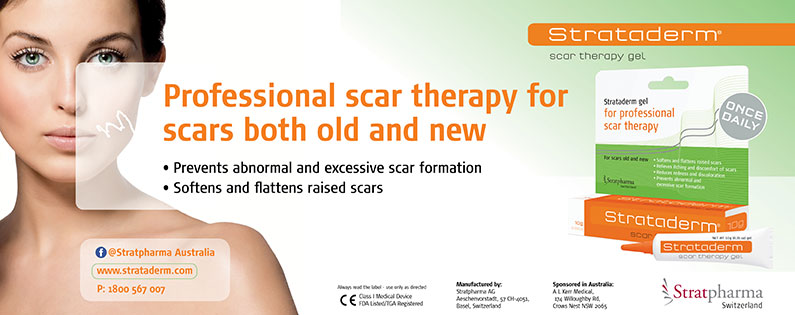
The advanced formulation of Strataderm has been developed using new silicone technology that has superior durability, skin-feel and drying time. The non-sticky, odourless formulation does not lead to secondary side-effects such as maceration, rashers, pruritus and infection and is therefore suitable for children and people with sensitive skin.
Strataderm scar therapy gel:
- Softens and flattens raised scars
- Relieves the itching and discomfort associated with scars
- Reduces redness and discolouration
- Prevents abnormal and excessive scar formation
How to use Strataderm
- Ensure that the scar is clean and dry
- Apply a very thin layer and allow to dry (3-4 minutes)
- Strataderm should be applied once daily, and maintained in continuous contact with the skin (24 hours/day)
- Once dry, Strataderm can be covered with sunscreen, cosmetics, pressure garments or casts
Strataderm is recommended as a minimum treatment of 60-90 days. Larger and older scars may take longer. Continued use is recommended until no further improvement is seen.
How much Strataderm do I need to minimise scarring?
| tube size | Scar size, which can be treated with one tube(twice daily application over 90 days) |
| 5g | linear scar, 2-3cm length |
| 10g | linear scar, 5-7cm length |
| 20g | linear scar, 10-12cm length |
| 50g | widespread scar, 6x12cm area |
Stratamark – Stretchmark Treatment
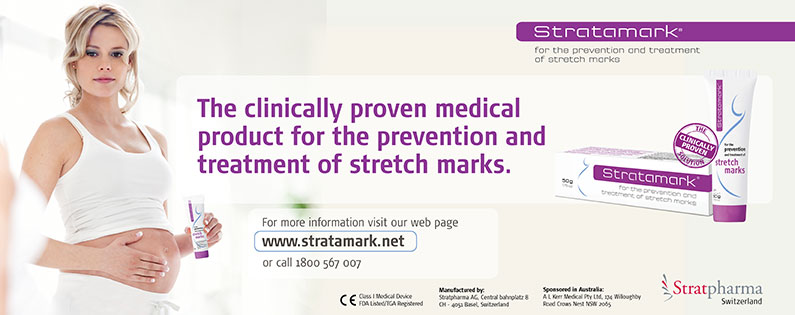
- Prevents stretch marks during pregnancy and growth spurts
- Prevents stretch marks caused by weight gain/loss or bodybuilding
- Softens and flattens stretch marks
- Reduces redness and discoloration associated with stretch marks
- Relieves the itching and discomfort of stretch marks
One of our favourite features of Stratamark is that it contains no alcohol, fragrances or parabens, which makes it suitable for pregnant women, breastfeeding mothers, children and people with sensitive skin.
Stratamark is also very economic in its application:
– One Stratamark 20g (0.7oz) tube contains enough gel for approximately one month treatment for women in the late stages of pregnancy.
– One Stratamark 50g (1.75oz) tube contains enough gel for approximately two months treatment for women in the late stages of pregnancy.
Stratamark also does not penetrate below the top layer of the skin and is ideally suited for use on people with sensitive skin.
Stratamark is a registered medical device.
Buy Stratapharma Products and minimise scarring
Further Reading about Scar Treatments
- Scar Management after Plastic Surgery by Dr Mark Doyle Gold Coast Plastic Surgery
- Skin & Scat Treatments by Dr Rebecca Wyten Melbourne Plastic Surgeon
- Recovery after Plastic Surgery – Dr. Guy Watts
- Risks and Complications of Surgery by Dr Carmen Munteanu FRACS (Plas)
- Silicone Strips for Scar Management after Plastic Surgery by Dr Michael Kernohan
- How To Minimise Scars After Breast Lift by Dr Jake Lim – Plastic Surgeon
- How Effective Are Silicone Strips for Plastic Surgery Scars by Dr Bish Soliman

